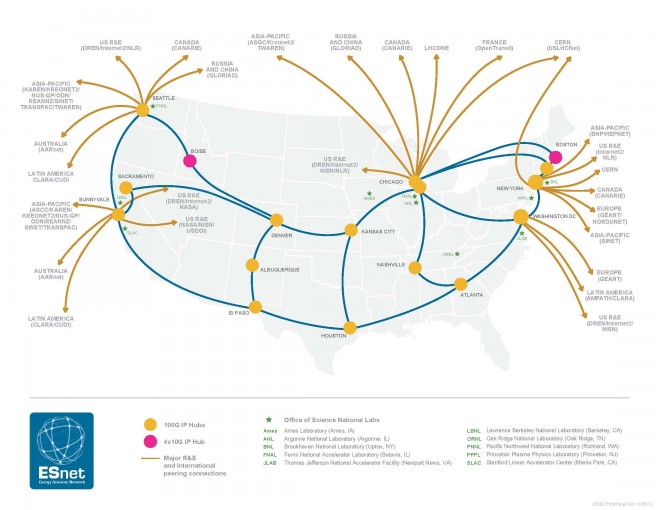
Illustration: dzima1/Getty
When Google chief financial officer Patrick Pichette said the tech giant might bring 10 gigabits per second internet connections
to American homes, it seemed like science fiction. That’s about 1,000
times faster than today’s home connections. But for NASA, it’s downright
slow.
While the rest of us send data across the public internet, the space agency uses a shadow network called ESnet, short for Energy Science Network, a set of private pipes that has demonstrated cross-country data transfers of 91 gigabits per second–the fastest of its type ever reported.
NASA isn’t going bring these speeds to homes, but it is using this
super-fast networking technology to explore the next wave of computing
applications. ESnet, which is run by the U.S. Department of Energy, is
an important tool for researchers who deal in massive amounts of data
generated by projects such as the Large Hadron Collider and the Human
Genome Project. Rather sending hard disks back and forth through the
mail, they can trade data via the ultra-fast network. “Our vision for
the world is that scientific discovery shouldn’t be constrained by
geography,” says ESnet director Gregory Bell.
In making its network as fast as it can possibly be, ESnet and
researchers are organizations like NASA are field testing networking
technologies that may eventually find their way into the commercial
internet. In short, ESnet a window into what our computing world will
eventually look like.
The Other Net
The first nationwide computer research network was the Defense
Department’s ARPAnet, which evolved into the modern internet. But it
wasn’t the last network of its kind. In 1976, the Department of Energy
sponsored the creation of the Magnetic Fusion Energy Network to connect
what is today the National Energy Research Scientific Computing Center
with other research laboratories. Then the agency created a second
network in 1980 called the High Energy Physics Network to connect
particle physics researchers at national labs. As networking became more
important, agency chiefs realized it didn’t make sense to maintain
multiple networks and merged the two into one: ESnet.
The nature of the network changes with the times. In the early days
it ran on land lines and satellite links. Today it is uses fiber optic
lines, spanning the DOE’s 17 national laboratories and many other sites,
such as university research labs. Since 2010, ESnet and Internet2—a
non-profit international network built in 1995 for researchers after the
internet was commercialized—have been leasing “dark fiber,” the excess
network capacity built-up by commercial internet providers during the
late 1990s internet bubble.
An Internet Fast Lane
In November, using this network, NASA’s High End Computer Networking
team achieved its 91 gigabit transfer between Denver and NASA Goddard
Space Flight Center in Greenbelt, Maryland. It was the fastest
end-to-end data transfer ever conducted under “real world” conditions.
ESnet has long been capable of 100 gigabit transfers, at least in
theory. Network equipment companies have been offering 100 gigabit
switches since 2010. But in practice, long-distance transfers were much
slower. That’s because data doesn’t travel through the internet in a
straight line. It’s less like a super highway and more like an
interstate highway system. If you wanted to drive from San Francisco to
New York, you’d pass through multiple cities along the way as you
transferred between different stretches of highway. Likewise, to send a
file from San Francisco to New York on the internet—or over ESnet—the
data will flow through hardware housed in cities across the country.

A map of ESnet’s connected sites. Image: Courtesy of ESnet
NASA did a 98 gigabit transfer between Goddard and the University of Utah over ESnet in 2012. And Alcatel-Lucent and BT obliterated that record
earlier this year with a 1.4 terabit connection between London and
Ipswich. But in both cases, the two locations had a direct connection,
something you rarely see in real world connections.
On the internet and ESnet, every stop along the way creates the
potential for a bottleneck, and every piece of gear must be ready to
handle full 100 gigabit speeds. In November, the team finally made it
work. “This demonstration was about using commercial, off-the-shelf
technology and being able to sustain the transfer of a large data
network,” says Tony Celeste, a sales director at Brocade, the company
that manufactured the equipment used in the record-breaking test.
Experiments for the Future
Meanwhile, the network is advancing the state of the art in other
ways. Researchers have used it to explore virtual network circuits
called “OSCARS,”
which can be used to create complex networks without complex hardware
changes. And they’re working on what are known as network “DMZs,” which can achieve unusually fast speeds by handling security without traditional network firewalls.
These solutions are designed specifically for networks in which a
small number of very large transfers take place–as opposed to the
commercial internet where lots of small transfers take place. But
there’s still plenty for commercial internet companies to learn from
ESnet. Telecommunications company XO Communications already has a 100 gigabit backbone, and we can expect more companies to follow suit.
Although we won’t see 10-gigabit connections—let alone 100 gigabit
connections—at home any time soon, higher capacity internet backbones
will mean less congestion as more and more people stream high-definition
video and download ever-larger files. And ESnet isn’t stopping there.
Bell says the organization is already working on a 400 gigabit network,
and the long-term goal is a terabyte per second network, which about
100,000 times faster than today’s home connections. Now that sounds like
science fiction.
Update 13:40 EST 06/17/14: This story has been updated to make it clear that ESnet is run by the Department of Energy.
Update 4:40 PM EST 06/17/14: This story has been updated to avoid
confusion between ESnet’s production network and its more experimental
test bed network.


